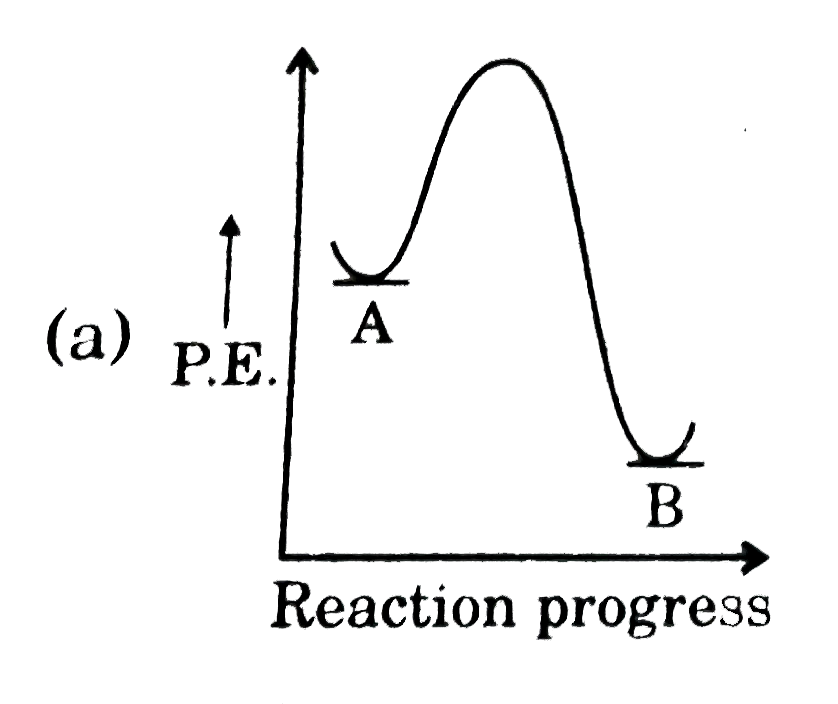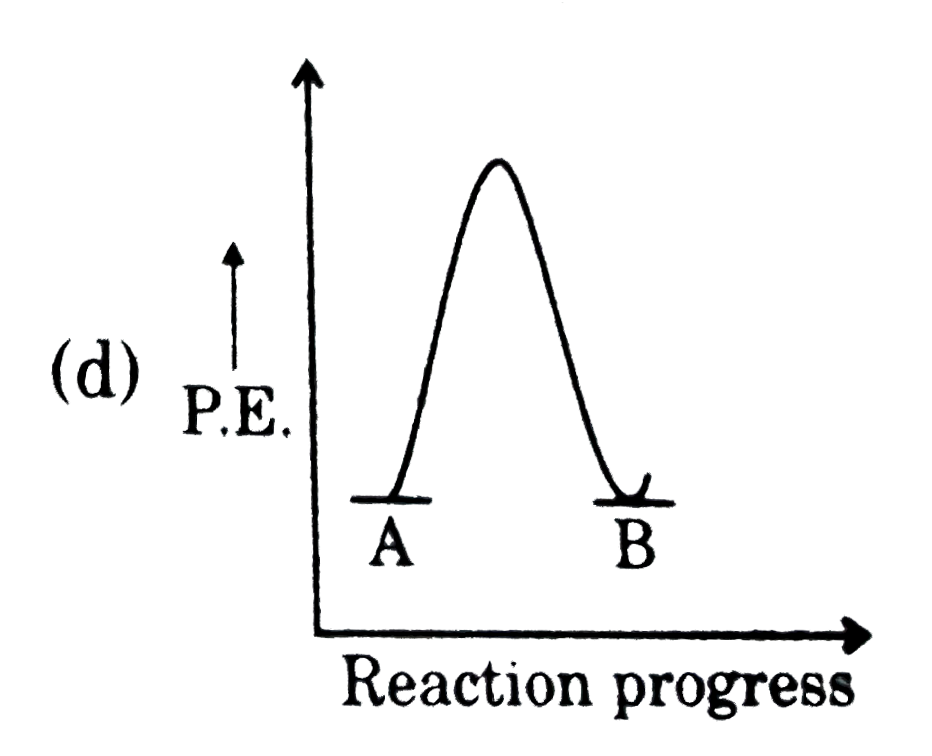For a reaction A→B, enthalpy of reaction is −4.2kJmol−1 and enthalpy of activation is 9.6KJmol−1. The correct potential energy profile for the reaction is shown in option.




To solve the problem, we need to analyze the given data about the reaction A→B and the enthalpy changes involved.
1. Understanding Enthalpy of Reaction:
- The enthalpy of reaction (ΔH) is given as −4.2kJ/mol. This indicates that the reaction is exothermic, meaning that energy is released when the reaction occurs.
2. Understanding Enthalpy of Activation:
- The enthalpy of activation (Ea) is given as 9.6kJ/mol. This is the energy barrier that must be overcome for the reaction to proceed from reactants to products.
3. Constructing the Potential Energy Profile:
- In a potential energy profile, the y-axis represents potential energy, and the x-axis represents the progress of the reaction.
- The starting point on the y-axis will be the energy level of the reactants (A). Since the reaction is exothermic, the energy level of the products (B) will be lower than that of the reactants.
4. Calculating the Energy Levels:
- Let’s denote the energy of the reactants as EA.
- The energy of the products can be calculated as:
EB=EA+ΔH=EA−4.2kJ/mol
- The activation energy indicates that the peak of the energy barrier (transition state) will be at:
ETS=EA+Ea=EA+9.6kJ/mol
5. Drawing the Profile:
- Start at EA (energy of reactants).
- Draw a peak at ETS (which is EA+9.6kJ/mol).
- End at EB (which is EA−4.2kJ/mol).
- The profile should show a rise to the peak followed by a drop to the lower energy level of the products.
6. Identifying the Correct Option:
- We need to compare the drawn potential energy profile with the provided options (1, 2, 3, and 4). The correct option will show:
- A peak above the reactants’ energy level.
- A final energy level of products that is lower than that of the reactants by 4.2 kJ.
- Based on the analysis, the correct option is option 4.
Summary:
The correct potential energy profile for the reaction A→B is represented in option 4, which illustrates the exothermic nature of the reaction with the appropriate activation energy barrier.
- The enthalpy of reaction (ΔH) is given as −4.2kJ/mol. This indicates that the reaction is exothermic, meaning that energy is released when the reaction occurs.
- The enthalpy of activation (Ea) is given as 9.6kJ/mol. This is the energy barrier that must be overcome for the reaction to proceed from reactants to products.
- In a potential energy profile, the y-axis represents potential energy, and the x-axis represents the progress of the reaction.
- The starting point on the y-axis will be the energy level of the reactants (A). Since the reaction is exothermic, the energy level of the products (B) will be lower than that of the reactants.
- Let’s denote the energy of the reactants as EA.
- The energy of the products can be calculated as:
EB=EA+ΔH=EA−4.2kJ/mol
- The activation energy indicates that the peak of the energy barrier (transition state) will be at:
ETS=EA+Ea=EA+9.6kJ/mol
- Start at EA (energy of reactants).
- Draw a peak at ETS (which is EA+9.6kJ/mol).
- End at EB (which is EA−4.2kJ/mol).
- The profile should show a rise to the peak followed by a drop to the lower energy level of the products.
- We need to compare the drawn potential energy profile with the provided options (1, 2, 3, and 4). The correct option will show:
- A peak above the reactants’ energy level.
- A final energy level of products that is lower than that of the reactants by 4.2 kJ.
- Based on the analysis, the correct option is option 4.
The correct potential energy profile for the reaction A→B is represented in option 4, which illustrates the exothermic nature of the reaction with the appropriate activation energy barrier.
Topper's Solved these Questions
Similar Questions
For a reaction A→B, Ea=10kJmol−1 and ΔH=5kJmol−1. Which is correct potential energy profile for the reaction?

View SolutionThe reaction X→Y is an exothermic reaction. Activation energy of the reaction for X into Y is 150 kJ mol−1. Enthalpy of reaction is 135 kJ mol−1. Calculate the activation energy for the reverse reaction, Y→X in kJmol−1.
View Solution
Knowledge Check
For an exothermic reaction A→B, the activation energy is 65kJmol−1 and enthalpy of reaction is 42kJmol−1. The activation energy for the reaction B→A will be:
A23kJmol−1B107kJmol−1C65kJmol−1D42kJmol−1The enthalpy of reaction, Δ1H, is
AΔr=H (product) +H (reactants)BΔr=H (reactants) −H (products)CΔr=H (product) −H (reactants)DΔr=H (reactants) +H (products)For a reaction A→B,Ea=10kJmol−1,ΔH=5kJmol−1. Thus, potential energy profile for this reaction is:
A B
B C
C D
D
In an exothermic reaction A→B, the activation energy of the forward reaction is 200kJmol−1. The enthalpy of the reaction is 280kJmol−1. The activation energy of the reverse reaction B→A is
View SolutionIf the activation enery for the forward reaction is 150kJ mol−1 and that of the reverse reaction is 260kJ mol−1. What is the ethalpy change for the reaction ?
View SolutionFor a reaction A→B,Ea=10kJ/mol,ΔH=5kJ/mol . Thus potential energy profile for this reaction is
View SolutionIf the activation enery for the forward reaction is 150kJ mol−1 and that of the reverse reaction is 260kJ mol−1. What is the ethalpy change for the reaction ?
View SolutionFor an exothermic reaction an activation energy of 70 KJ mole −1 and the enthalpy change of reaction is 30 KJ mole −1 . The order of the reaction is
View Solution
